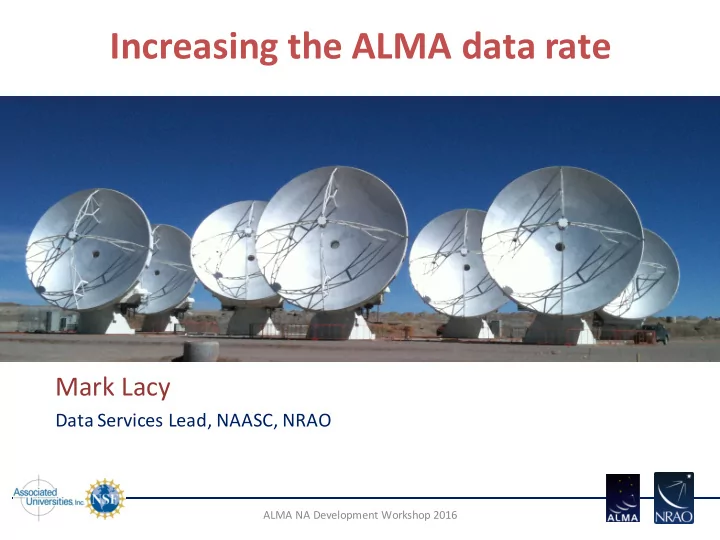

Increasing the ALMA data rate Mark Lacy Data Services Lead, NAASC, NRAO ALMA NA Development Workshop 2016
Some science cases for high(er) data rates and their implications Larger bandwidths • – More continuum sensitivity. – More lines (at the same resolution) per observation. – Probably ~OK with scaling of existing data transfer infrastructure for up to ~32GHz bandwidth. New observing techniques • – On the fly interferometry (fast surveys) – Probably ~OK with scaling of existing raw data transfer infrastructure, major issue will be imaging. Focal plane arrays • – Potential huge increase in survey speed – Depending on size of arrays (and if they are installed on all antennas, not just TP and/or ACA), may need a dramatic change in the data management plan.
Data transfer • Three stages: – AOS to Santiago – Santiago to Miami – Miami to Cville
Data transfer within Chile Upgrade project from ALMA development • program gives 2.5Gb/s from AOS to Santiago: – OSF to Calama fiber built 2014; waiting on revised environmental impact report before “official” use, unofficially is now working. – Calama to Antofagasta provided by Telefonica – Antofagasta to SCO from EVALSO/REUNA (Chilean academic network provider) – Redundant fiber loop via Argentina planned Primary ALMA archive in Santiago (SCO) • Santiago to ARCs: individual ARC contracts. •
Santiago to Miami • NRAO works with the South American Astronomy Coordinating Committee (SAACC) to provide network to the US. • Joint AUI-AURA agreement gives NRAO 100Mb/s burstable to 600Mb/s (in practice). Can be improved if/when needed. – Main provider is Amlight (Florida International University). • Also AUI-REUNA MOU for local transfer from ESO campus to hub in Santiago. • Network links to South America improving rapidly.
Within the US • Within the US, use academic high speed networks (Internet 2) to University of Virginia. • Once at UVa, 2Gb/s link to NRAO (will upgrade to 10Gb/s). Current main bottleneck is thus Santiago to Miami, can be improved if needed/justified though.
Current ALMA data rates Operations plan D assumed 200TB/yr (6.3MB/s) in Full Science. • – Early (Cycle-1/2) fears that this data rate would be greatly exceeded have not been founded (helped by Phase-2 policies and user education), and data rate justification has been removed from proposals. ALMA in Cycle 4 will produce about 100TB (/yr) in raw data. • – (in practice 200TB/yr as data will be stored both WVR corrected and uncorrected, but this should only be temporary) – Image products are currently only ~10% of data, but this is expected to increase significantly when the imaging pipeline is fully operational. For raw data in Full Science (more efficient plus a few more antennas than • Cycle 4), the ops plan estimate is probably good, will need to increased depending on the size of the products (largely dictated by processing resources). We are assuming 500TB/yr in Full Science operations (Cycle 5+).
“Hard” data rate limits • Correlator network infrastructure (64MB/s [512Mb/s]) – Low enough that for some projects (long baseline [short sampling time]) and full resolution spwwe hit this limit (especially when taking both WVR corrected and uncorrected data streams). – No problem getting this to Santiago over 2.5Gb/s link. – Could (fairly) easily boost SCO->MIA link to this capacity. – An improvement would allow better long baseline observations, and a richer archive. • Raw correlator output is 512MB/s (using 4-bit visibilities). Would be difficult to transmit (4Gb/s).
The ALMA data challenge Existing infrastructure can probably support raw data rates ~2-4 times larger than • at present. (Other ARCs not quite so well situated, but solutions could be found.) Processing the data can be a challenge though. Currently 2.5 months behind on • processing (dominated by organizational issues). Until now, reference images only generated. Pipeline into operation in Cycle 4. – Imaging demands depend on configuration (problem scales with longest baseline – squared). • Small configurations (<1km), image data volume <~ raw data volume even if mapping all channels at full resolution to the edge of the primary beam. • Large configurations more problematic, image data volume can greatly exceed raw for short snapshots, imaging process can run for weeks (radio interferometry can be a very efficient compression algorithm!). • Still have to explore what we can practically make for pipeline image products in large configurations. • Images also need to be mirrored out of SCO master archive, increasing load on data transfer out of Chile
Summary Strong science cases exist for increased data rates arising from • improvements to correlators and receivers. An agreement with AURA (DES, LSST) have allowed NA to obtain • good data connections to Chile. Improvements in connectivity to South America (triggered by Rio Olympics) mean that regular internet is also much better (and can be used for backup). A factor of 2-4 increase in raw data rate could probably be • supported at a reasonable cost (though would need to be justified and accounted). Still uncertain is the cost/difficulty of imaging even the current data • in the largest configurations at full spatial+spectralresolution over the full primary beam, and its implications for data transfer to/from Chile.
Recommend
More recommend